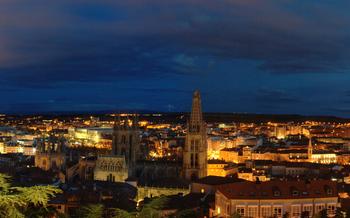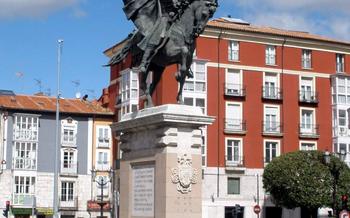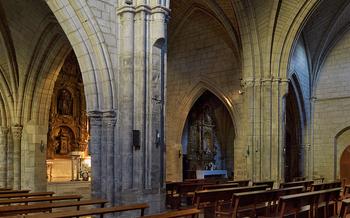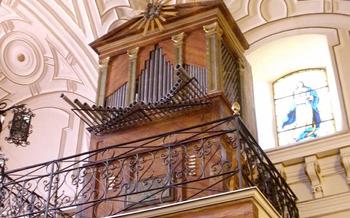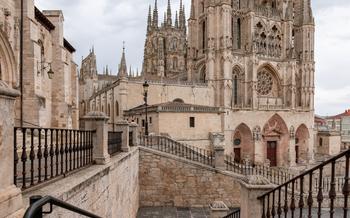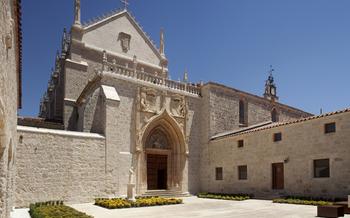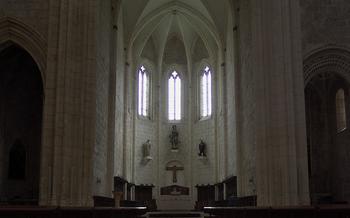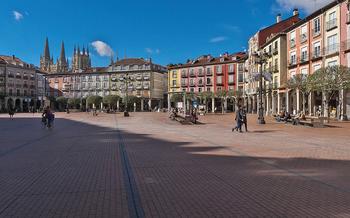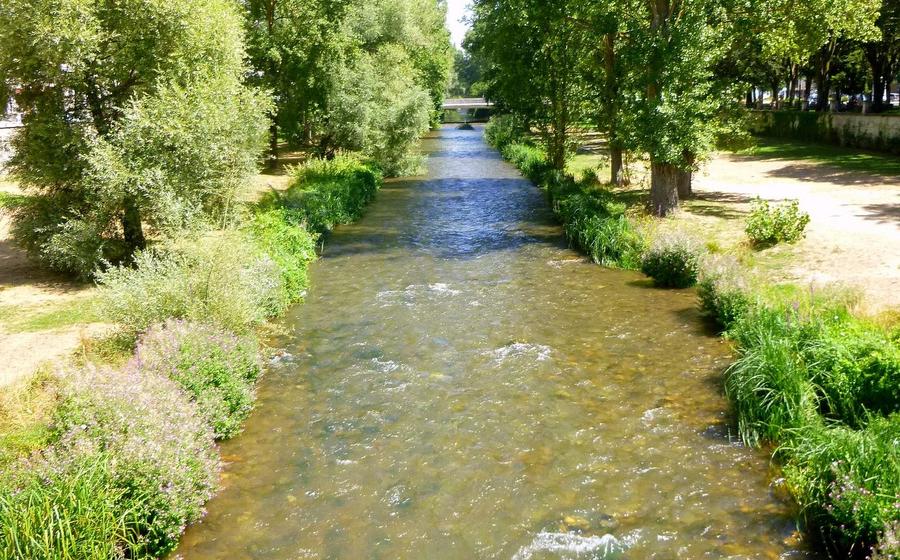
Río Arlanzón
- Exploring the Parque del Castillo
- Visiting the Monasterio de San Pedro de Cardeña
- Crossing the Puente de San Pablo
- Admire the Monumento al Cid
- Relax at Playa de Fuente Prior
- Discover the Río Arlanzón's Flora and Fauna
- Embark on a Boat Ride
- Attend the Fiestas de San Pedro y San Pablo
- Savor the Local Cuisine
- Visit the Burgos Cathedral
- Explore the Plaza Mayor
- Shop at Calle Sombrerería
- Insider Tip: Visit the Museo del Río Arlanzón
Exploring the Parque del Castillo
The Parque del Castillo, located on the banks of the Río Arlanzón, is a must-visit destination for anyone interested in history, nature, and breathtaking views. The park's centerpiece is the Castillo de Burgos, a medieval fortress that has stood guard over the city for centuries. Visitors can explore the castle's imposing walls, towers, and dungeons, which offer a glimpse into the city's rich past.
In addition to its historical significance, the Parque del Castillo is also home to a wealth of archaeological treasures. Excavations have uncovered the remains of ancient Roman settlements, as well as medieval pottery and coins. These discoveries provide valuable insights into the city's origins and development.
Despite its historical importance, the Parque del Castillo is also a place of natural beauty. The park's lush green spaces, dotted with trees and flowers, provide a tranquil oasis in the heart of the city. Visitors can stroll along the park's winding paths, enjoying the fresh air and the stunning views of the river and the city skyline.
Anecdote: The ghost of the castle
According to local legend, the ghost of a medieval knight haunts the Parque del Castillo. The knight, who was killed in battle, is said to roam the castle's ramparts, searching for his lost love. Visitors to the park who are brave enough to venture out at night may catch a glimpse of the knight's ghostly figure, still searching for his beloved after all these years.
Visiting the Monasterio de San Pedro de Cardeña
The Monasterio de San Pedro de Cardeña is a Benedictine monastery located just a few kilometers from Burgos. Founded in the 9th century, it is one of the oldest and most important monasteries in Spain. The monastery has a rich history, having been a center of learning and culture for centuries. It was also home to the tomb of El Cid, the legendary Castilian knight, until his remains were moved to the Burgos Cathedral in the 20th century.
Architectural Heritage The Monasterio de San Pedro de Cardeña is a beautiful example of Romanesque architecture. The church, built in the 12th century, features a simple yet elegant design with a barrel-vaulted ceiling and a large apse. The cloister, added in the 13th century, is one of the most well-preserved Romanesque cloisters in Spain. It features a series of intricate carvings depicting scenes from the Bible and the life of Saint Benedict.
Historical Significance The Monasterio de San Pedro de Cardeña played an important role in the history of Spain. It was a center of learning and culture during the Middle Ages, and its scriptorium produced some of the most important manuscripts of the time. The monastery was also a major center of the Benedictine Order, and its abbots were often appointed to high positions in the church.
Artistic Treasures The Monasterio de San Pedro de Cardeña is home to a number of important works of art. The most notable is the tomb of El Cid, which was commissioned by his wife, Doña Jimena, after his death in 109The tomb is a masterpiece of Romanesque sculpture and features a life-size effigy of El Cid in full armor.
Anecdote: The Legend of the Founding of the Monastery According to legend, the Monasterio de San Pedro de Cardeña was founded by a group of monks who were fleeing from the Muslim invasion of Spain. The monks were led by a holy man named Pedro, who had a vision of the Virgin Mary telling him to build a monastery on the banks of the Río Arlanzón. The monks followed Pedro's instructions and founded the monastery in the 9th century.
Crossing the Puente de San Pablo
The Puente de San Pablo, gracefully spanning history and architectural prowess. Constructed in the 13th century, this fortified bridge has withstood the test of time, serving as a vital link between the city center and the San Pedro de Cardeña monastery. Its sturdy structure, featuring three pointed arches and a fortified gate, reflects the strategic importance of this crossing during medieval times.
As you cross the bridge, take a moment to admire the panoramic views of the river and the surrounding landscape. The bridge's elevated position offers a unique perspective, allowing you to appreciate the city's layout and its relationship with the river. The reflection of the bridge's arches in the water creates a picturesque scene that captures the essence of Burgos' architectural heritage.
Anecdote: The Story of the Bridge's Construction
Legend has it that the construction of the Puente de San Pablo was initiated by a pious woman named doña Sancha, who sought to provide a safe passage for pilgrims traveling to the monastery of San Pedro de Cardeña. With the help of local stonemasons, she oversaw the construction of the bridge, dedicating it to Saint Paul, the patron saint of travelers.
As the bridge neared completion, doña Sancha faced a dilemma: the final stone needed to complete the arch was too heavy to be lifted into place. In a moment of desperation, she turned to Saint Paul for guidance. Miraculously, the stone became weightless, allowing her to effortlessly place it in its position, ensuring the bridge's structural integrity.
Admire the Monumento al Cid
In the heart of Burgos, gazing El Cid astride his faithful steed, Babieca, his imposing figure radiating strength and determination. His right hand grasps the hilt of his sword, Tizona, ready to defend his honor and protect his homeland. The intricate details of the sculpture, from the intricate armor to the flowing mane of Babieca, showcase the exceptional craftsmanship of the artist, Juan Cristóbal.
Beyond its artistic merits, the Monumento al Cid holds profound historical significance. El Cid, a renowned military leader and national hero, embodied the values of chivalry, loyalty, and unwavering courage. His exploits during the Reconquista, the centuries-long struggle to reclaim the Iberian Peninsula from Muslim rule, earned him a place among Spain's most celebrated figures.
The monument serves as a constant reminder of El Cid's unwavering devotion to his country and his pivotal role in shaping the course of Spanish history. It invites visitors to reflect on the enduring legacy of this legendary warrior and to appreciate the profound impact he continues to have on the Spanish psyche.
Relax at Playa de Fuente Prior
Escape the urban hustle and find tranquility at the Playa de Fuente Prior, an oasis nestled along the banks of the Río Arlanzón. This artificial beach offers a refreshing retreat, inviting visitors to bask in the warm Spanish sun, embrace the serenity of nature, and indulge in a variety of recreational activities.
Families flock to this idyllic spot, where children can frolic in the sand, splash in the shallow waters, and let their imaginations run wild. The gentle currents and lifeguards on duty ensure a safe and enjoyable experience for all.
For those seeking adventure, the Playa de Fuente Prior offers opportunities for kayaking, canoeing, and paddle boarding. Glide across the tranquil waters, surrounded by lush greenery and the gentle chirping of birds, and immerse yourself in the tranquility of the natural surroundings.
As the sun begins to set, the atmosphere at the Playa de Fuente Prior transforms into a magical haven. The sky erupts in a kaleidoscope of colors, casting a warm glow on the glistening waters and creating a picturesque backdrop for a romantic evening stroll.
Anecdote: The Story of the Creation of the Playa de Fuente Prior
The creation of the Playa de Fuente Prior is a testament to the community's dedication to preserving and enhancing the natural beauty of the Río Arlanzón. In the early 2000s, local residents and environmental enthusiasts joined forces to transform a neglected stretch of riverbank into a vibrant public space.
Through tireless efforts and collaboration with local authorities, they secured funding and resources to construct the beach, ensuring that future generations could enjoy the river's beauty and recreational opportunities. Today, the Playa de Fuente Prior stands as a symbol of community spirit and the power of collective action.
Discover the Río Arlanzón's Flora and Fauna
The Río Arlanzón is home to a diverse array of flora and fauna. Along its banks, visitors can spot native species such as the black poplar, the white willow, and the ash tree. The river is also a crucial habitat for a variety of animal species, including the otter, the kingfisher, and the gray heron.
In recent years, significant conservation efforts have been undertaken to protect the river's ecosystem. These efforts have been successful in increasing the populations of several endangered species, such as the European eel and the salmon.
For birdwatchers, the Río Arlanzón offers a unique opportunity to observe a wide variety of species. The river is a popular spot for migratory birds, such as the common crane and the white stork. Visitors can also spot a variety of resident birds, such as the great spotted woodpecker and the European greenfinch.
Anecdote:
One of the most remarkable stories about the Río Arlanzón's fauna is the return of the salmon. In the early 20th century, the salmon population in the river was decimated due to overfishing and pollution. However, thanks to conservation efforts, the salmon have made a remarkable comeback in recent years. Today, visitors to the Río Arlanzón can once again see these majestic fish leaping out of the water.
Embark on a Boat Ride
Glide along the tranquil waters of the Río Arlanzón aboard a traditional boat and immerse yourself in the enchanting scenery that unfolds before your eyes. Let the gentle current guide you past verdant riverbanks, ancient bridges, and historical landmarks, each with a story to tell.
As you navigate the river's meanders, listen to the informative commentary provided by your knowledgeable guide, who will regale you with tales of the region's rich past and point out notable sights along the way. From the majestic Burgos Cathedral to the picturesque Monasterio de San Pedro de Cardeña, every bend in the river reveals a new treasure.
Indulge in the unique perspective that a boat ride offers, allowing you to appreciate the city from a different angle. Capture stunning photographs of the riverside landscapes and iconic monuments, creating lasting memories of your visit to Burgos.
Anecdote:
One sunny afternoon, a boatman named Juan embarked on a leisurely ride down the Río Arlanzón. As he approached a shallow stretch of the river, he noticed a young child struggling to stay afloat. Without hesitation, Juan skillfully maneuvered his boat towards the child and extended a helping hand. With a gentle pull, he brought the child to safety, earning the gratitude of the child's parents and the admiration of onlookers.
Attend the Fiestas de San Pedro y San Pablo
The Fiestas de San Pedro y San Pablo are a week-long celebration that takes place in Burgos every year in late June. The festivities are a showcase of the city's rich culture and traditions, with a variety of events and activities that cater to all ages.
The highlight of the fiestas is the procession of the patron saints, San Pedro and San Pablo, which takes place on the final day of the festivities. The procession is a colorful and lively affair, with hundreds of people dressed in traditional costumes parading through the streets of Burgos.
Other popular events during the fiestas include concerts, dancing, bullfights, and fireworks displays. There are also plenty of food stalls and market stalls selling local delicacies and souvenirs.
One of the most memorable moments of the fiestas is the story of the miracle of the rain. According to legend, in the year 1680, a terrible drought struck Burgos during the fiestas. The people prayed to San Pedro and San Pablo for rain, and on the final day of the fiestas, a torrential downpour occurred, saving the city from the drought.
To this day, the people of Burgos celebrate the miracle of the rain every year during the Fiestas de San Pedro y San Pablo. It is a reminder of the city's deep faith and its gratitude to its patron saints.
Savor the Local Cuisine
Burgos' gastronomy is a delicious reflection of its history and culture. Indulge in the flavors of traditional dishes such as Olla Podrida, a hearty stew made with chickpeas, various meats, and vegetables; or Morcilla de Burgos, a succulent blood sausage seasoned with spices and rice. For a truly unique culinary experience, try the Queso de Burgos, a soft, fresh cheese made from sheep's milk.
Don't miss the opportunity to visit the city's many pintxos bars, where you can sample a variety of small plates and snacks. These delectable bites are perfect for sharing and offer a delightful way to explore the local cuisine.
To satisfy your sweet tooth, head to one of the city's pastelerías and indulge in bollos preñaos, a traditional pastry filled with chorizo and bacon, or yemas de Santa Teresa, a sweet treat made with egg yolks and sugar.
One local delicacy with a fascinating origin story is the Burgos morcilla. Legend has it that during the Middle Ages, a group of pilgrims traveling through Burgos ran out of food. Desperate for sustenance, they knocked on the door of a local inn and asked for something to eat. The innkeeper, moved by their plight, offered them a humble meal of bread and blood sausage. The pilgrims were so grateful for this act of kindness that they vowed to spread the word about the deliciousness of Burgos morcilla, which eventually became a beloved dish throughout the region.
Visit the Burgos Cathedral
The crowning jewel of Burgos, and one of the most magnificent cathedrals in all of Spain, is the Catedral de Santa María la Mayor. A masterpiece of Gothic architecture, it was constructed over a period of several centuries, beginning in the 13th century. The result is a breathtaking edifice that seamlessly blends architectural elements from different eras.
Inside, the cathedral is adorned with an awe-inspiring array of artistic treasures. The Capilla del Condestable, for example, is a marvel of Renaissance architecture, while the Capilla de los Reyes contains the tombs of several Castilian monarchs. The cathedral is also home to a number of exquisite stained-glass windows, which bathe the interior in a kaleidoscope of colors.
Beyond its architectural and artistic significance, Burgos Cathedral holds deep historical importance. It was here that the Catholic Monarchs, Isabella I of Castile and Ferdinand II of Aragon, were married in 1469, an event that would shape the course of Spanish history.
Anecdote: The story of the Burgos Cathedral's construction
Legend has it that the construction of Burgos Cathedral was inspired by a vision experienced by King Alfonso VIII. In a dream, he saw a ladder reaching from earth to heaven, with angels ascending and descending. Upon waking, the king interpreted this vision as a sign that he should build a magnificent cathedral in Burgos.
Whether or not this legend is true, there is no doubt that the Burgos Cathedral is a testament to the faith and devotion of the people of Burgos. It is a place of immense beauty and spirituality, and a must-visit for anyone traveling to the city.
Explore the Plaza Mayor
The Plaza Mayor, the beating heart of Burgos, is a magnificent square that showcases the city's rich history and architectural heritage. This lively square, once a bustling marketplace, has been the city's nerve center for centuries.
The Plaza Mayor is surrounded by elegant buildings, each telling a unique story. Gaze upon the majestic Burgos Cathedral, its Gothic spires piercing the sky, and the Casa del Cordón, a stunning Renaissance palace adorned with intricate carvings.
Immerse yourself in the vibrant atmosphere as locals and tourists mingle, enjoying the shade of the trees or savoring a cup of coffee at one of the many cafés. Browse the stalls of local vendors selling traditional crafts, souvenirs, and regional delicacies.
Don't miss the opportunity to visit the Teatro Principal, a beautiful theater hosting a variety of performances throughout the year. And as the sun sets, the square transforms into a magical place, with the buildings illuminated and the air filled with the sounds of music and laughter.
Anecdote:
In the 16th century, the Plaza Mayor was the site of a lively market, where locals and merchants from all over the region converged to trade goods and socialize. One day, a young woman named María arrived at the market with her father to sell their handmade pottery. As they set up their stall, María noticed a handsome young man watching her from afar.
Intrigued, María couldn't resist stealing glances at the young man, and soon their eyes met. A spark ignited between them, and they exchanged shy smiles. Throughout the day, they found excuses to cross paths, exchanging meaningful looks and kind words.
As the sun began to set, the market drew to a close. María and her father packed up their belongings, but as they were about to leave, the young man approached them. He introduced himself as Juan, and they exchanged a few more words before he asked María if he could accompany her home.
María blushed and glanced at her father, who gave her a knowing smile. With her father's blessing, María and Juan walked together through the streets of Burgos, their hearts filled with newfound love, a love that had blossomed in the vibrant Plaza Mayor.
Shop at Calle Sombrerería
Calle Sombrerería is. It offers a unique shopping experience, where visitors can immerse themselves in local culture and traditions. The street is lined with small shops that showcase the finest of Burgos's craftsmanship. From traditional souvenirs to handmade jewelry and unique art pieces, Calle Sombrerería has something for everyone. Visitors can find everything from traditional Spanish fans to intricately carved wooden figurines. The street is also home to several antique shops, where one can unearth hidden treasures and one-of-a-kind pieces. For those looking for a truly authentic experience, Calle Sombrerería is a must-visit.
Anecdote: The Story of the Street's Name
The name "Calle Sombrerería" literally translates to "Hat Street" in Spanish. The origins of this name can be traced back to the 16th century when the street was home to a thriving hat-making community. At the time, Burgos was a major center for hat production, and the city's hat makers were renowned for their exquisite craftsmanship. The street became known as Calle Sombrerería due to the numerous hat shops that lined its sidewalks. Today, while the hat-making industry in Burgos has declined, the name Calle Sombrerería remains a testament to the city's rich history and cultural heritage.
Insider Tip: Visit the Museo del Río Arlanzón
For a to visit the Museo del Río Arlanzón, located in the heart of the city. This interactive museum offers a fascinating journey through the river's past, present, and future.
Through engaging exhibits and educational displays, the museum showcases the river's role in shaping the city's identity. Learn about the river's geological formation, its importance as a trade route, and its influence on the city's architecture and culture.
One of the highlights of the museum is the "River of Life" exhibit, which features a stunning 3D model of the Río Arlanzón and its surroundings. Visitors can explore the river's course, discover its hidden treasures, and learn about the diverse flora and fauna that call it home.
The Museo del Río Arlanzón is a must-visit for anyone interested in understanding the deep connection between the city of Burgos and its river. It's a place where history, nature, and culture come together to create a truly unique experience.


